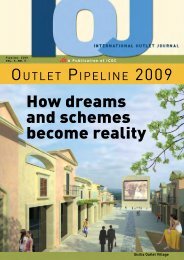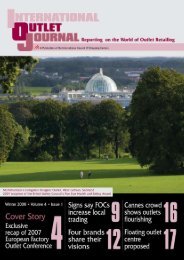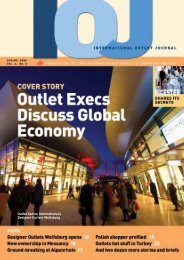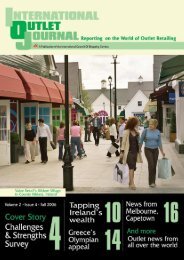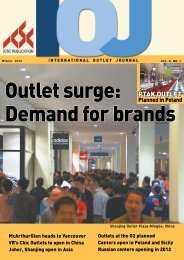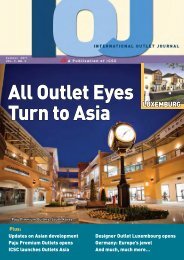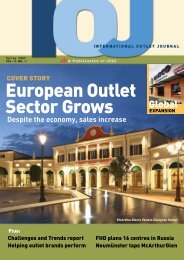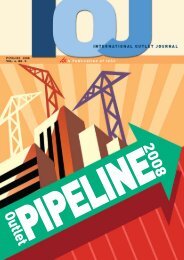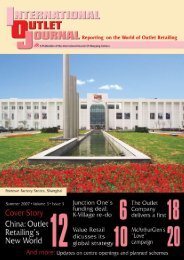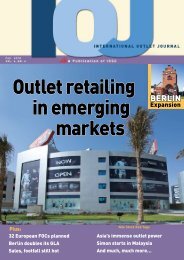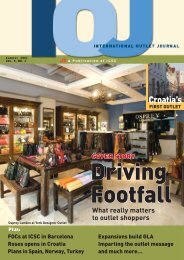For Designer Style, It's All Outlet - Value Retail News
For Designer Style, It's All Outlet - Value Retail News
For Designer Style, It's All Outlet - Value Retail News
Create successful ePaper yourself
Turn your PDF publications into a flip-book with our unique Google optimized e-Paper software.
next two to three years, only two have<br />
so far been completed. How many of<br />
the remaining will actually open “will be<br />
decided by the retailers,” he said.<br />
Huge and empty<br />
Brad Stipe devoted most of his session,<br />
“Fundamentals of Conceiving<br />
and Developing an <strong>Outlet</strong> Project,” to<br />
design. He stressed the importance of<br />
aesthetics, the advantages of racetrack<br />
configurations, and the importance of<br />
signage and graphics that “can make or<br />
break a project.”<br />
From a design and land-use perspective,<br />
he said, China presents real challenges,<br />
particularly the high-density requirements.<br />
The need to accommodate<br />
high density calls for multi-level outlet<br />
centers, a model that hasn’t worked in<br />
the rest of the world.<br />
“Most successful projects have always<br />
been one or two levels, usually just one<br />
level,” he said. Citing projects he had<br />
worked on in Japan – which had similar<br />
density issues – he said developers<br />
managed to deal with them and still stay<br />
within two levels.<br />
Another issue for China is the penchant<br />
for constructing more space than<br />
necessary. Stipe said maintaining an image<br />
of success at all times is critical, thus a<br />
project’s size must be appropriate for the<br />
market and tenant demand. By developing<br />
in phases, the developer both minimizes<br />
risk and maintains an image of success by<br />
keeping occupancy rates high.”<br />
Developers had lots of issues to think<br />
about, he said. “The population centers<br />
are much, much larger, income disparity<br />
much greater, and retail saturation of<br />
international and U.S. domestic brands<br />
is limited to low. Brand awareness,<br />
while higher in the first-tier cities, really<br />
drops off precipitously as you get to the<br />
third-tier cities.”<br />
In the final analysis, Stipe said, China’s<br />
outlet industry can achieve success by<br />
“following proven methods now, and<br />
evolving later.”<br />
Partnerships in all<br />
shapes and sizes<br />
Trying to explain the root of China’s<br />
sometimes odd partnerships, Jiang Jun,<br />
CEO of Shanghai-based Zaihang Real<br />
Estate Consulting, said central government<br />
land policy had effectively pushed<br />
small operators, residential developers,<br />
Richard Hamilton, Taubman Asia’s VP-development, stressed the importance of<br />
strong partnership when developing retail centers in China<br />
manufacturers and other groups into the<br />
same corner. Their common denominator<br />
is this: Though they’re all aware of the<br />
outlet phenomenon, they had little or no<br />
background in retail<br />
but they all owned<br />
land or had access<br />
to it in the suburbs.<br />
And many of<br />
them, she added,<br />
were familiar with<br />
planning issues and<br />
Jiang Jun<br />
maintained close<br />
relationships with<br />
local government, making them seasoned<br />
partners in tasks such as securing<br />
land plots and permits.<br />
As Jiang put it, “What they’re missing,<br />
and what they readily acknowledge, is retail<br />
and outlet expertise, brand relationships,<br />
leasing and management knowledge.”<br />
Obviously they have much to learn,<br />
and some outlet players appear keen to<br />
fill the knowledge gap. European-based<br />
outlet operator Fashion House, for<br />
example, addressed just this group in an<br />
ad in the <strong>Outlet</strong>s Asia program, offering<br />
consulting and franchise services<br />
to “any independent developers with<br />
suitable land plots, either with relevant<br />
permits or the ability to secure planning<br />
approvals, along with access to a construction<br />
capability but without specialist<br />
knowledge of the outlet market.”<br />
That said, partnerships can sometimes<br />
take strange turns. Richard Hamilton,<br />
Taubman Asia’s VP development, offered<br />
a foreign investor’s perspective on China<br />
and spent a lot of time on the topic of<br />
partnership.<br />
“In 2006, we were introduced to a<br />
project opportunity in Macau for a mixeduse<br />
casino resort. Besides the casino, the<br />
project comprised four hotels, theater,<br />
mall and convention facilities. It was a terrific<br />
site,” Hamilton said, at the Macau end<br />
of the Lotus Bridge to China, the region’s<br />
biggest source of gaming tourism.<br />
“The existing partners looked to<br />
Taubman to undertake the retail component,<br />
some 60,000 m2,” he said. And<br />
Taubman liked the odds, reckoning<br />
the project would yield a net operating<br />
income in excess of $80 million. So the<br />
developer signed for 25 percent of the<br />
retail component, as much as the partners<br />
were prepared to cede.<br />
“We started work in 2007 and inherited<br />
this terrible plan that had parallel<br />
malls, terrible site lines, no consideration<br />
of vertical transport [a critical detail<br />
since the mall was to be on an upper<br />
level] and we got to work and came up<br />
with a racetrack design,” Hamilton said.<br />
“What we quickly discovered working<br />
with our partners was that they were<br />
quite dysfunctional. There was a local<br />
landowner along with two foreign fund<br />
managers who were unaligned in terms<br />
of their interests. Very quickly the project<br />
stalled.”<br />
Decisions couldn’t be made and the<br />
financing required to keep the project<br />
(continued on page 28)<br />
Fall 2011 InternAtIOnAl <strong>Outlet</strong> JOurnAl 27





